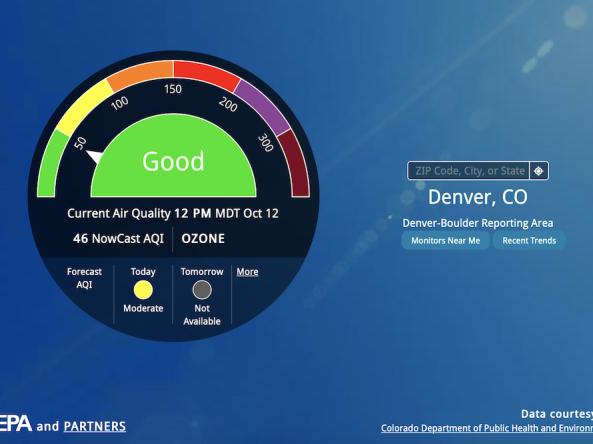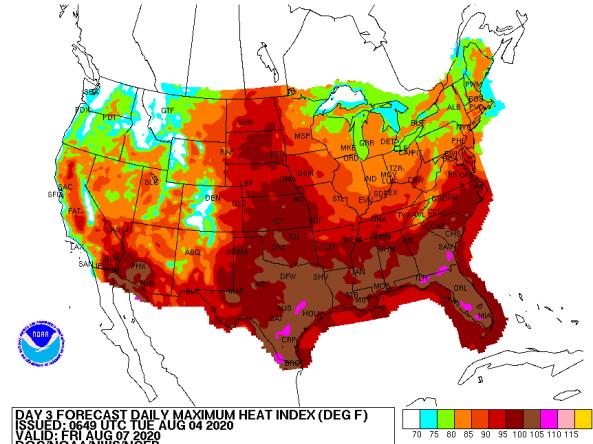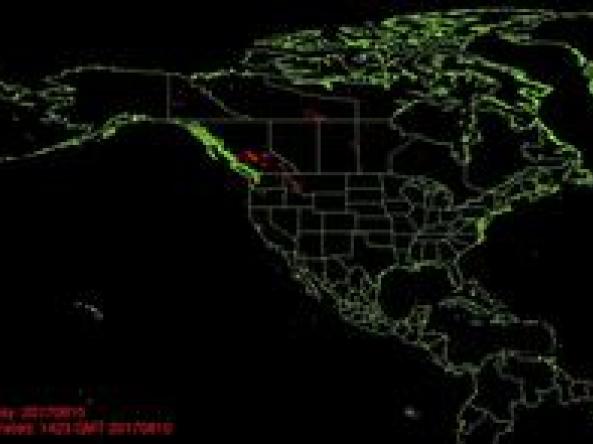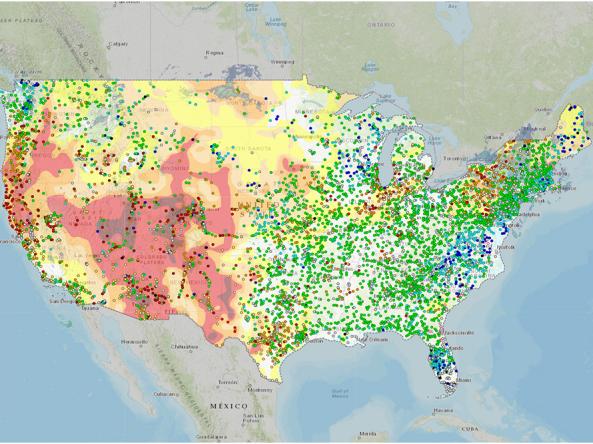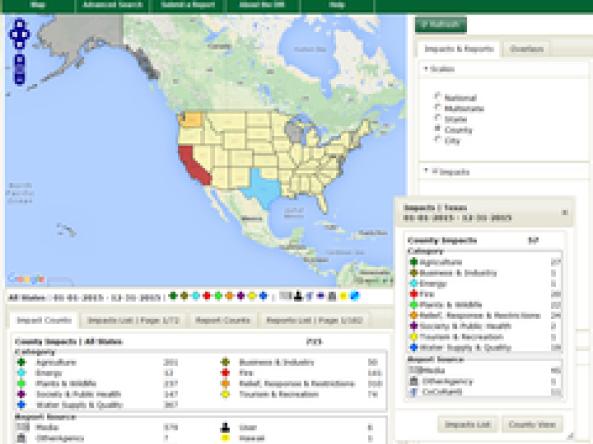Public Health
Some health effects of drought are easy to observe and measure, but drought’s slow rise can result in indirect health implications that are more difficult to recognize.
Drought and Public Health
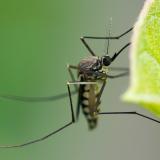
Over the last century, droughts have caused more deaths internationally than any other weather- or climate-related disaster. In the United States, drought impacts on public health include changes in air quality, changes in water quality and quantity, increased incidence of illness and disease, and mental health effects.
This map shows current National Weather Service Heat Advisories, Excessive Heat Watches, and Excessive Heat Warnings for counties across the U.S.
- Heat Advisories and Excessive Heat Warnings are issued within 12 hours of the onset of extremely dangerous heat conditions, based on the maximum heat index (typically >100°F or >105°F, respectively, but this varies by location).
- Excessive Heat Watches are issued when conditions are favorable for an excessive heat event in the next 24 to 72 hours, but its occurrence and timing is still uncertain.
Learn more about these warnings on Weather.gov.
The U.S. Air Quality Index (AQI) is designed to communicate whether air quality is healthy or unhealthy. This map displays the AQI at sensors across the U.S. alongside the current U.S. Drought Monitor, as of 10 a.m. Eastern.
A hazardous heat risk area typically indicates a 40% or greater chance of exceeding NWS Heat Advisory criteria, based on the Heat Index for your location, or widespread major (level 3) or scattered extreme (level 4) HeatRisk.
Air temperature can have wide-ranging effects on natural processes. Warmer air temperatures increase evapotranspiration—which is the combination of evaporation from the soil and bodies of water and transpiration from plants—and lower soil moisture.
Learn MoreExtreme weather events can interact or cascade—where one disaster event triggers or changes the probability of another event. For example, drought conditions can increase the probability of large-scale wildfires, and droughts are often accompanied by extreme heat. By including drought in multi-hazard planning, a community can consolidate its resources and develop coordinated responses before a disaster.
Learn MoreDrought can cause significant human health outcomes that can challenge public health departments, emergency managers, and healthcare providers. Drought can lead to decreased water quantity and quality, increased incidence of illness or disease, increased mortality rates, and adverse mental health outcomes as livelihoods are challenged.
Learn MoreDrought can cause significant human health outcomes that can challenge public health departments, emergency managers, and healthcare providers. Drought can lead to decreased water quantity and quality, increased incidence of illness or disease, increased mortality rates, and adverse mental health outcomes as livelihoods are challenged.
Learn MoreDuring drought conditions, fuels for wildfire, such as grasses and trees, can dry out and become more flammable. Drought can also increase the probability of ignition and the rate at which fire spreads. Temperature, soil moisture, humidity, wind speed, and fuel availability (vegetation) are all factors that interact to influence the frequency of large wildfires.
Learn MoreAir temperature can have wide-ranging effects on natural processes. Warmer air temperatures increase evapotranspiration—which is the combination of evaporation from the soil and bodies of water and transpiration from plants—and lower soil moisture.
Learn MoreFlash drought is the rapid onset or intensification of drought. Unlike slow-evolving drought, which is caused by a decline in precipitation, flash drought occurs when low precipitation is accompanied by abnormally high temperatures, high winds, and/or changes in radiation. These sometimes-rapid changes can quickly raise evapotranspiration rates and remove available water from the landscape.
Learn MoreDrought can reduce the water availability and water quality necessary for productive farms, ranches, and grazing lands, resulting in significant negative direct and indirect economic impacts to the agricultural sector. Monitoring agricultural drought typically focuses on examining levels of precipitation, evaporative demand, soil moisture, and surface/groundwater quantity and quality.
Learn MoreExtreme weather events can interact or cascade—where one disaster event triggers or changes the probability of another event. For example, drought conditions can increase the probability of large-scale wildfires, and droughts are often accompanied by extreme heat. By including drought in multi-hazard planning, a community can consolidate its resources and develop coordinated responses before a disaster.
Learn MoreNational Weather Service Heat Warnings
Excessive Heat Watch
Heat Watches are issued when conditions are favorable for an excessive heat event in the next 24 to 72 hours. A Watch is used when the risk of a heat wave has increased, but its occurrence and timing is still uncertain. Learn more from the National Weather Service.
Heat Advisory
A Heat Advisory is issued within 12 hours of the onset of extremely dangerous heat conditions. The general rule is when the maximum heat index temperature is expected to be 100°F or higher for at least 2 days, and nighttime air temperatures will not drop below 75°F. However, these criteria vary across the country, especially for areas that are not used to dangerous heat conditions. Learn more from the National Weather Service.
Excessive Heat Warning
An Excessive Heat Warning is issued within 12 hours of the onset of extremely dangerous heat conditions. The general rule is when the maximum heat index temperature is expected to be 105°F or higher for at least 2 days, and nighttime air temperatures will not drop below 75°F. However, these criteria vary across the country, especially for areas not used to extreme heat conditions. Learn more from the National Weather Service.
Air Quality
AQI 0 to 50: Good
Air quality is satisfactory, and air pollution poses little or no risk. Learn more.
AQI 51 to 100: Moderate
Air quality is acceptable. However, there may be a risk for some people, particularly those who are unusually sensitive to air pollution. Learn more.
AQI 101 to 150: Unhealthy for Sensitive Groups
Members of sensitive groups may experience health effects. The general public is less likely to be affected. Learn more.
AQI 151 to 200: Unhealthy
Some members of the general public may experience health effects; members of sensitive groups may experience more serious health effects. Learn more.
AQI 201 to 300: Very Unhealthy
Health alert: The risk of health effects is increased for everyone. Learn more.
AQI >301: Hazardous
Health warning of emergency conditions: everyone is more likely to be affected. Learn more.
U.S. Drought Monitor
D0 - Abnormally Dry
Abnormally Dry (D0) indicates a region that is going into or coming out of drought, according to the U.S. Drought Monitor. View typical impacts by state.
D1 – Moderate Drought
Moderate Drought (D1) is the first of four drought categories (D1–D4), according to the U.S. Drought Monitor. View typical impacts by state.
D2 – Severe Drought
Severe Drought (D2) is the second of four drought categories (D1–D4), according to the U.S. Drought Monitor. View typical impacts by state.
D3 – Extreme Drought
Extreme Drought (D3) is the third of four drought categories (D1–D4), according to the U.S. Drought Monitor. View typical impacts by state.
D4 – Exceptional Drought
Exceptional Drought (D4) is the most intense drought category, according to the U.S. Drought Monitor. View typical impacts by state.
Hazard Outlook for Days 3–7
Risk of Hazardous Heat
This area has a risk for hazardous heat 3 days from now through 7 days from now. This typically means that National Weather Service forecasters predict a 40% or greater chance of exceeding widespread NWS Heat Advisory criteria, based on the Heat Index for your location. Or, for the West, widespread major (level 3) or scattered extreme (level 4) HeatRisk is present.
This map shows current National Weather Service Heat Advisories, Excessive Heat Watches, and Excessive Heat Warnings for counties across the U.S.
- Heat Advisories and Excessive Heat Warnings are issued within 12 hours of the onset of extremely dangerous heat conditions, based on the maximum heat index (typically >100°F or >105°F, respectively, but this varies by location).
- Excessive Heat Watches are issued when conditions are favorable for an excessive heat event in the next 24 to 72 hours, but its occurrence and timing is still uncertain.
Learn more about these warnings on Weather.gov.
The U.S. Air Quality Index (AQI) is designed to communicate whether air quality is healthy or unhealthy. This map displays the AQI at sensors across the U.S. alongside the current U.S. Drought Monitor, as of 10 a.m. Eastern.
A hazardous heat risk area typically indicates a 40% or greater chance of exceeding NWS Heat Advisory criteria, based on the Heat Index for your location, or widespread major (level 3) or scattered extreme (level 4) HeatRisk.
This map is updated daily on Drought.gov. To see the latest heat advisories, watches, and warnings from the National Weather Service, visit Weather.gov.
On Drought.gov, Air Quality Index maps are updated daily at 10 a.m. Eastern. View hourly air quality information from AirNow.
The National Weather Service's Weather Prediction Center issues the Day 3–7 Hazards Outlook daily Monday–Friday by 3:30 p.m. EST/4:30 p.m. EDT. This map is updated on Drought.gov around 7 p.m. ET Monday–Friday.
Air temperature can have wide-ranging effects on natural processes. Warmer air temperatures increase evapotranspiration—which is the combination of evaporation from the soil and bodies of water and transpiration from plants—and lower soil moisture.
Learn MoreExtreme weather events can interact or cascade—where one disaster event triggers or changes the probability of another event. For example, drought conditions can increase the probability of large-scale wildfires, and droughts are often accompanied by extreme heat. By including drought in multi-hazard planning, a community can consolidate its resources and develop coordinated responses before a disaster.
Learn MoreDrought can cause significant human health outcomes that can challenge public health departments, emergency managers, and healthcare providers. Drought can lead to decreased water quantity and quality, increased incidence of illness or disease, increased mortality rates, and adverse mental health outcomes as livelihoods are challenged.
Learn MoreDrought can cause significant human health outcomes that can challenge public health departments, emergency managers, and healthcare providers. Drought can lead to decreased water quantity and quality, increased incidence of illness or disease, increased mortality rates, and adverse mental health outcomes as livelihoods are challenged.
Learn MoreDuring drought conditions, fuels for wildfire, such as grasses and trees, can dry out and become more flammable. Drought can also increase the probability of ignition and the rate at which fire spreads. Temperature, soil moisture, humidity, wind speed, and fuel availability (vegetation) are all factors that interact to influence the frequency of large wildfires.
Learn MoreAir temperature can have wide-ranging effects on natural processes. Warmer air temperatures increase evapotranspiration—which is the combination of evaporation from the soil and bodies of water and transpiration from plants—and lower soil moisture.
Learn MoreFlash drought is the rapid onset or intensification of drought. Unlike slow-evolving drought, which is caused by a decline in precipitation, flash drought occurs when low precipitation is accompanied by abnormally high temperatures, high winds, and/or changes in radiation. These sometimes-rapid changes can quickly raise evapotranspiration rates and remove available water from the landscape.
Learn MoreDrought can reduce the water availability and water quality necessary for productive farms, ranches, and grazing lands, resulting in significant negative direct and indirect economic impacts to the agricultural sector. Monitoring agricultural drought typically focuses on examining levels of precipitation, evaporative demand, soil moisture, and surface/groundwater quantity and quality.
Learn MoreExtreme weather events can interact or cascade—where one disaster event triggers or changes the probability of another event. For example, drought conditions can increase the probability of large-scale wildfires, and droughts are often accompanied by extreme heat. By including drought in multi-hazard planning, a community can consolidate its resources and develop coordinated responses before a disaster.
Learn MoreAirNow is a one-stop source for air quality data, including current and forecast air quality maps and data for more than 500 cities across the U.S., as well as Canada and Mexico.
The National Weather Service (NWS) issues heat index forecasts for days 3–7, including daily maximum heat index, daily mean heat index, and daily minimum heat index forecasts.
The National Environmental Public Health Tracking Network brings together data on environments and hazards, health effects, and population health from national, state,
A selection of NOAA fire and smoke products.
The National Water Dashboard is an interactive map viewer that shows provisional real-time water data from more than 13,000 USGS observation stations in context with weather-related data
Drought Impacts Reporter (DIR): an interactive database of drought impacts in the U.S., by location, data, type, and cost built from stakeholder, government, media and other reports.
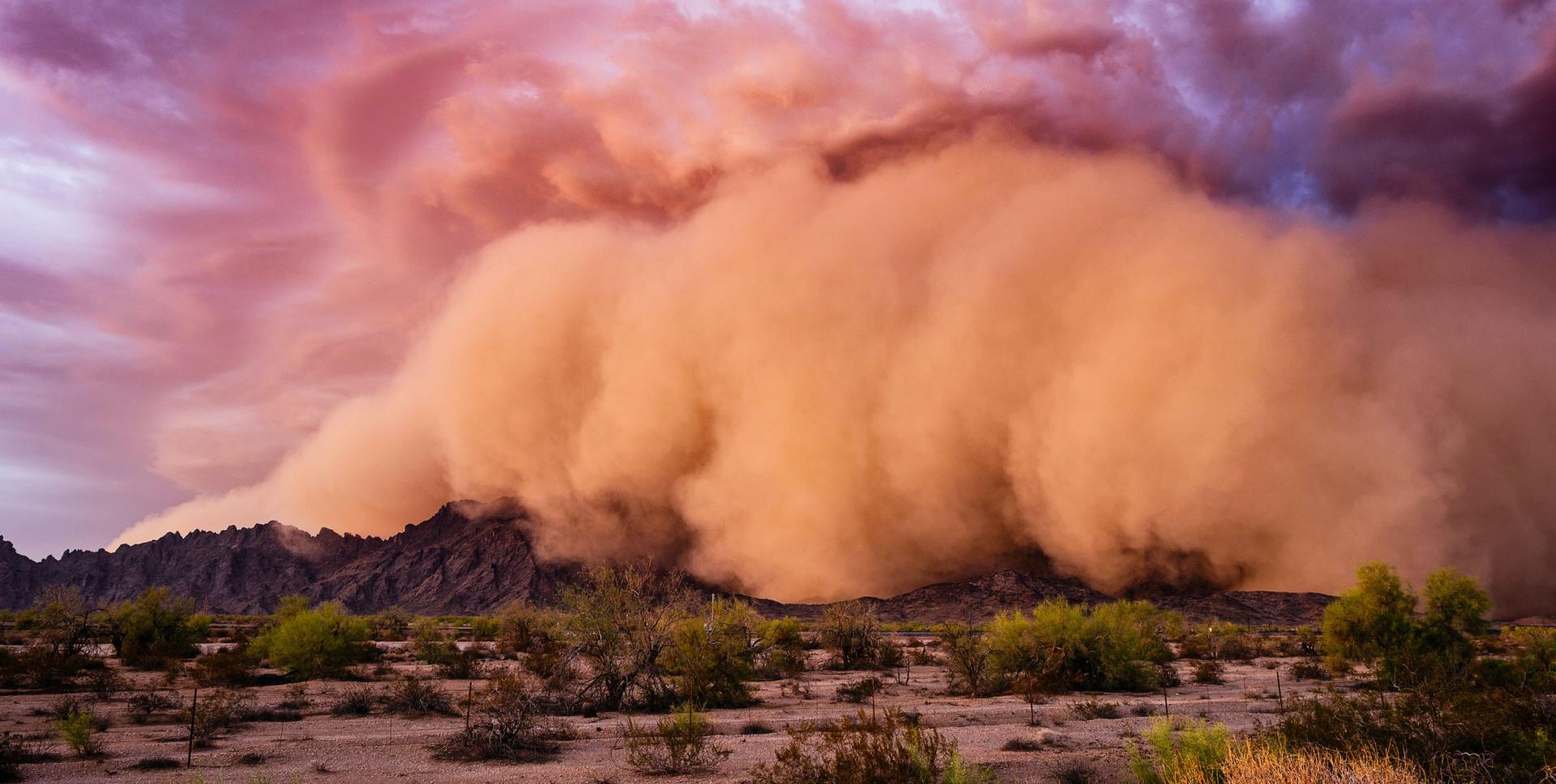
Impacts and Related Content
Air Quality
Air quality can decrease during drought events as a result of dust storms or wildfires. Particulates in the air irritate the lungs and bronchial passages and exacerbate chronic respiratory conditions.
Increased Incidence of Illness and Disease
Drought conditions can change how often and where certain diseases occur. For instance, mosquitoes that carry West Nile virus can move to new locations when water bodies become stagnant and create new breeding grounds. Also, there is a higher risk for contracting a lung infection called Valley Fever, caused by a fungus in the soil, in dry and dusty soil conditions.
Mental Health Impacts
Complex relationships between drought and its associated economic consequences can increase mood disorders, domestic violence, and suicide.
By Sector | Public Health
The impacts of drought on hospital admissions and deaths depend on drought severity and the history of droughts in a region. Learn more about drought's impacts on the public health sector.
Public Health Research and Resources
Web Resources
Centers for Disease Control and Prevention (CDC) | Drought and Health
CDC | Health Impacts of Drought
EPA | Natural Disasters Resource
NOAA | National Integrated Heat Health Information System (NIHHIS)
NOAA | National Weather Service | Heat Safety Tips and Resources
Occupational Safety and Health Administration | Heat Illness Prevention Campaign


